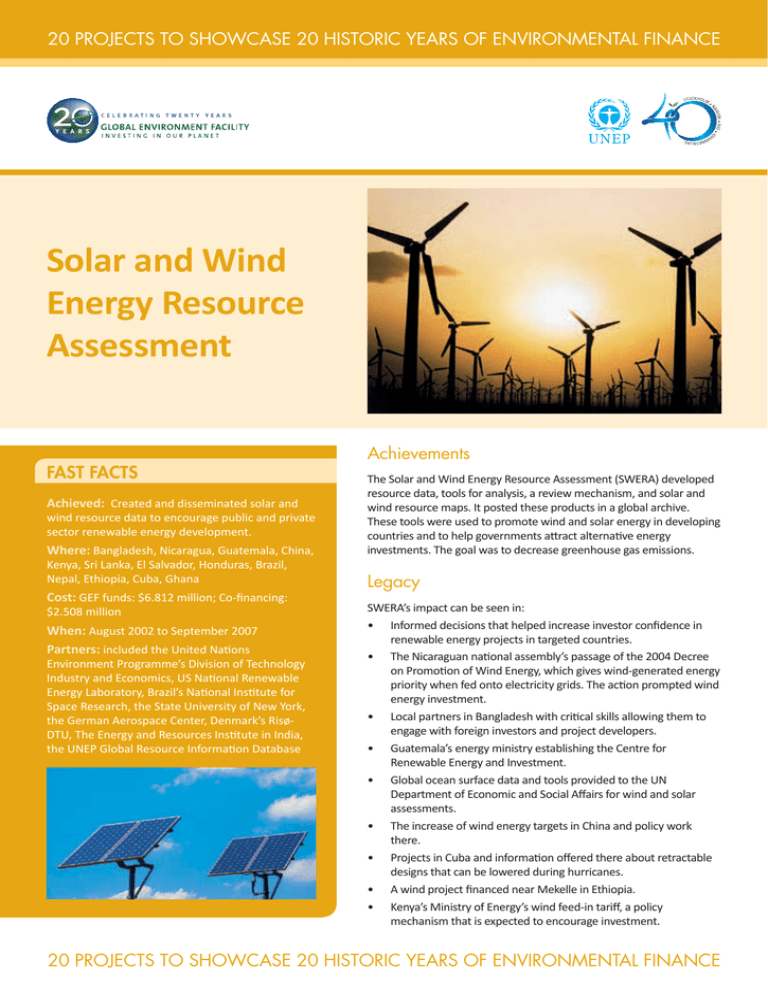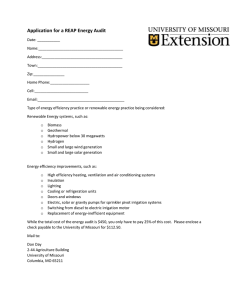Solar and Wind Energy Resource Assessment
advertisement

20 Projects to Showcase 20 Historic Years of Environmental Finance Solar and Wind Energy Resource Assessment Fast Facts Achieved: Created and disseminated solar and wind resource data to encourage public and private sector renewable energy development. Where: Bangladesh, Nicaragua, Guatemala, China, Kenya, Sri Lanka, El Salvador, Honduras, Brazil, Nepal, Ethiopia, Cuba, Ghana Cost: GEF funds: $6.812 million; Co-financing: $2.508 million When: August 2002 to September 2007 Partners: included the United Nations Environment Programme’s Division of Technology Industry and Economics, US National Renewable Energy Laboratory, Brazil’s National Institute for Space Research, the State University of New York, the German Aerospace Center, Denmark’s Risø‐ DTU, The Energy and Resources Institute in India, the UNEP Global Resource Information Database Achievements The Solar and Wind Energy Resource Assessment (SWERA) developed resource data, tools for analysis, a review mechanism, and solar and wind resource maps. It posted these products in a global archive. These tools were used to promote wind and solar energy in developing countries and to help governments attract alternative energy investments. The goal was to decrease greenhouse gas emissions. Legacy SWERA’s impact can be seen in: • Informed decisions that helped increase investor confidence in renewable energy projects in targeted countries. • The Nicaraguan national assembly’s passage of the 2004 Decree on Promotion of Wind Energy, which gives wind-generated energy priority when fed onto electricity grids. The action prompted wind energy investment. • Local partners in Bangladesh with critical skills allowing them to engage with foreign investors and project developers. • Guatemala’s energy ministry establishing the Centre for Renewable Energy and Investment. • Global ocean surface data and tools provided to the UN Department of Economic and Social Affairs for wind and solar assessments. • The increase of wind energy targets in China and policy work there. • Projects in Cuba and information offered there about retractable designs that can be lowered during hurricanes. • A wind project financed near Mekelle in Ethiopia. • Kenya’s Ministry of Energy’s wind feed-in tariff, a policy mechanism that is expected to encourage investment. 20 Projects to Showcase 20 Historic Years of Environmental Finance 20 Projects to Showcase 20 Historic Years of Environmental Finance Solar and Wind Energy Resource Assessment What People Say: Countries need greatly expanded energy services to help in the fight against poverty and to power sustainable development. SWERA offers them the technical and policy assistance to capture the potential that renewable energy can offer. - Klaus Toepfer, UNEP’s former executive director Publications: Information, resources and data on renewable energy that were produced by the project can be found at: http://swera.unep.net Outputs and Deliverables: SWERA was able to: • Map the solar and wind resources of 13 developing countries and identify thousands of megawatts of renewable energy potential. • Produce solar and wind data sets and maps at better spatial scales of resolution than previously available. • Prove that Nicaragua had greater wind resources than previously estimated. • Integrate results into a computer-based, geo-referenced information system containing relevant infrastructure data such as roads and transmission lines. • Transfer capacity to the 13 countries so they can use the SWERA tools. • Give countries tools to produce national reports on solar and wind energy development. • Generate maps that generalized the total wind assessment potentials for about a third of China. • Identify Inner Mongolia as a suitable location for concentrated solar power systems or large-scale photovoltaic installations. Partners: Partners included UNEP Division of Technology, Industry and Economics, German Aerospace, USGS Earth Resource Observation and Science, United Nations Environment Program, National Aeronautics and Space Administration, National Renewable Energy Laboratory, UNEP Global Resource Information Database, Risø DTU National Laboratory, State University of New York at Albany Solar Research Group, National Agency for Space Research in Brazil, American Council on Renewable Energy, CANMET Energy Technology Centre, US Export-Import Bank, Engineering and Environment and International Business Development Divisions, The Energy Research Institute in India, Southwest Windpower, US Agency for International Development, U.S. Office of Energy Efficiency and Renewable Energy, Solar Energy Industries Association, Stella Group, American Wind Energy Association, U.S. Department of State, The World Bank, Langley Research Center’s Atmospheric Science Data Center, Surface Meteorology and Solar Energy, RETScreen International, Natural Resources Canada, Deutsche Gesellschaft für Technische Zusammenarbeit (GTZ), Renewable Energy Research Centre, Electrical Energy Research Center, Brazilian Wind Energy Center, Laboratory of Solar Energy, Chinese Renewable Energy Industries Association, Agencia de Ciencia y Tecnologia, Universidad, Universidad Centroamericana José Simeón Cañas, Renewable Energy in the Americas, Brazilian Solar and Wind Energy Reference Center, Center for Renewable Energy Development, Ministerio de Medio Ambiente Recursos Naturales, Ethiopian Rural Energy Development & Promotion Center, Ministerio Energía y Minas, Ministra de Recursos Naturales y Amiente, Department of Meteorology, University of Nairobi, Alternative Energy Promotion Centre, National Engineering Research and Development Centre, Ministry of Energy in Kenya, Centre for Energy Studies in Nepal, Ministry of Mines and Energy in Ghana, Comisión Nacional de Energía Contact: www.unep.org/dgef or email: gefinfo@unep.org Photo Credit: Larry Prosor/UNEP 20 Projects to Showcase 20 Historic Years of Environmental Finance




